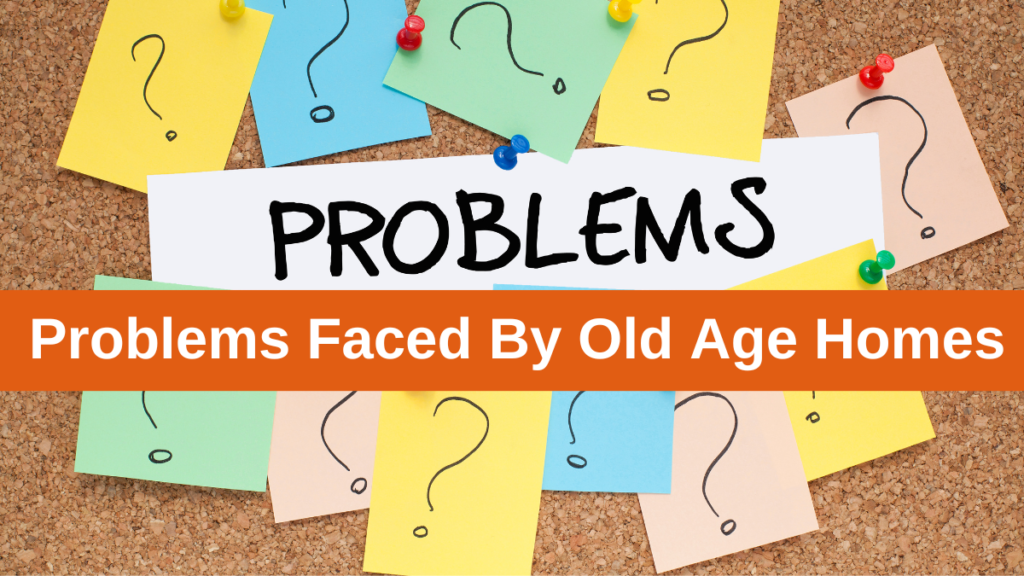INTRODUCTION
Old age homes play a vital role in offering care and support to the elderly who may lack family assistance or need specialized attention during their later years. Despite their well-intentioned efforts, the old age homes encounter various challenges that significantly impact the residents’ well-being. In this detailed discussion, we’ll explore the multifaceted problems faced by old age homes, touching upon financial constraints, healthcare obstacles, social isolation, concerns of neglect and abuse, loss of autonomy, and accessibility issues.
Some of the major problems faced by old-age homes are
- Financial Constraints
A significant challenge that old age homes grapple with, is the ongoing struggle with financial limitations. Providing a nurturing environment for seniors, quality care and amenities requires substantial financial resources. Unfortunately, many of the old age homes find themselves dealing with tight budgets, which can compromise the overall quality of services provided. From being short in staff to deal with inadequate infrastructure, financial constraints pose a substantial hurdle in ensuring the well-being of residents.
- Healthcare Challenges
Elderly residents often have complex healthcare needs that demand specialized care. However, many old age homes lack essential medical equipment, technology, and well-trained staff to effectively address these health issues. The absence of comprehensive healthcare solutions within these institutions poses a significant challenge, as seniors may require ongoing medical attention for managing chronic conditions and handling emergent health concerns.
- Understanding Particular Illnesses
There is a dearth of knowledge and information regarding particular ailments that affect the elderly residents. It is clear that mental health concerns are rarely mentioned, and our nation is unable to handle the rising rate of dementia, depression, and Alzheimer’s among the senior population. Even in large metropolises’ senior home care services, there are not facilities that can efficiently manage geriatric health.
- Social Isolation
Despite being surrounded by their peers, seniors in old age homes frequently face feeling of loneliness and isolation. The lack of meaningful social connections can contribute to mental health issues like depression and anxiety. As family members may be geographically distant or unavailable, fostering a supportive and engaging social environment within these homes becomes crucial to alleviate the negative effects of social isolation.
- Ageism and the Loss of Meaning
An abundance of outdated misconceptions about the elderly contribute to their marginalization and isolation in many communities. Developing innovative ways to include senior citizens in social events helps them maintain their sense of self and identity while also utilizing the priceless quantity of knowledge and experience they have to offer—a vital resource for the advancement of society.
- Neglect and Abuse
A distressing challenge that some old age homes grapple with is instances of neglect, abuse, or mistreatment toward residents. Factors like understaffing, poor management, and inadequate staff training can contribute to these unfortunate incidents. Recognizing and addressing this challenge is essential to ensure the safety and well-being of the elderly population entrusted to the care of these institutions.
- Loss of Autonomy
A common concern among seniors in old age homes is the perceived loss of independence and autonomy. Restrictions on daily routines, meal choices, and social interactions can lead to feelings of helplessness and frustration among residents. Striking a balance between providing necessary care and preserving the autonomy of the elderly is crucial for creating a positive and empowering living environment.
- Accessibility Challenges
Old-age homes may lack the necessary features to cater to the diverse needs of seniors with mobility or sensory impairments. The absence of accessibility features can result in accidents and injuries, further compromising the well-being of residents. Addressing these challenges involves not only physical modifications but also a commitment to creating an inclusive environment that accommodates the diverse needs of the elderly population.
CONCLUSION
Old age homes serve as essential institutions that provide a haven for seniors who may lack family support or need specialized care. However, the challenges faced by these facilities are complex and diverse, encompassing financial constraints, healthcare obstacles, social isolation, concerns of neglect and abuse, loss of autonomy, and accessibility issues. Recognizing and addressing problems faced by Old age homes is crucial to fulfilling their mission of providing a safe, supportive, and enriching environment for elderly people. As society continues to age, it becomes increasingly important to invest in solutions that enhance the quality of life for our senior citizens, both within and outside the confines of old-age homes.

